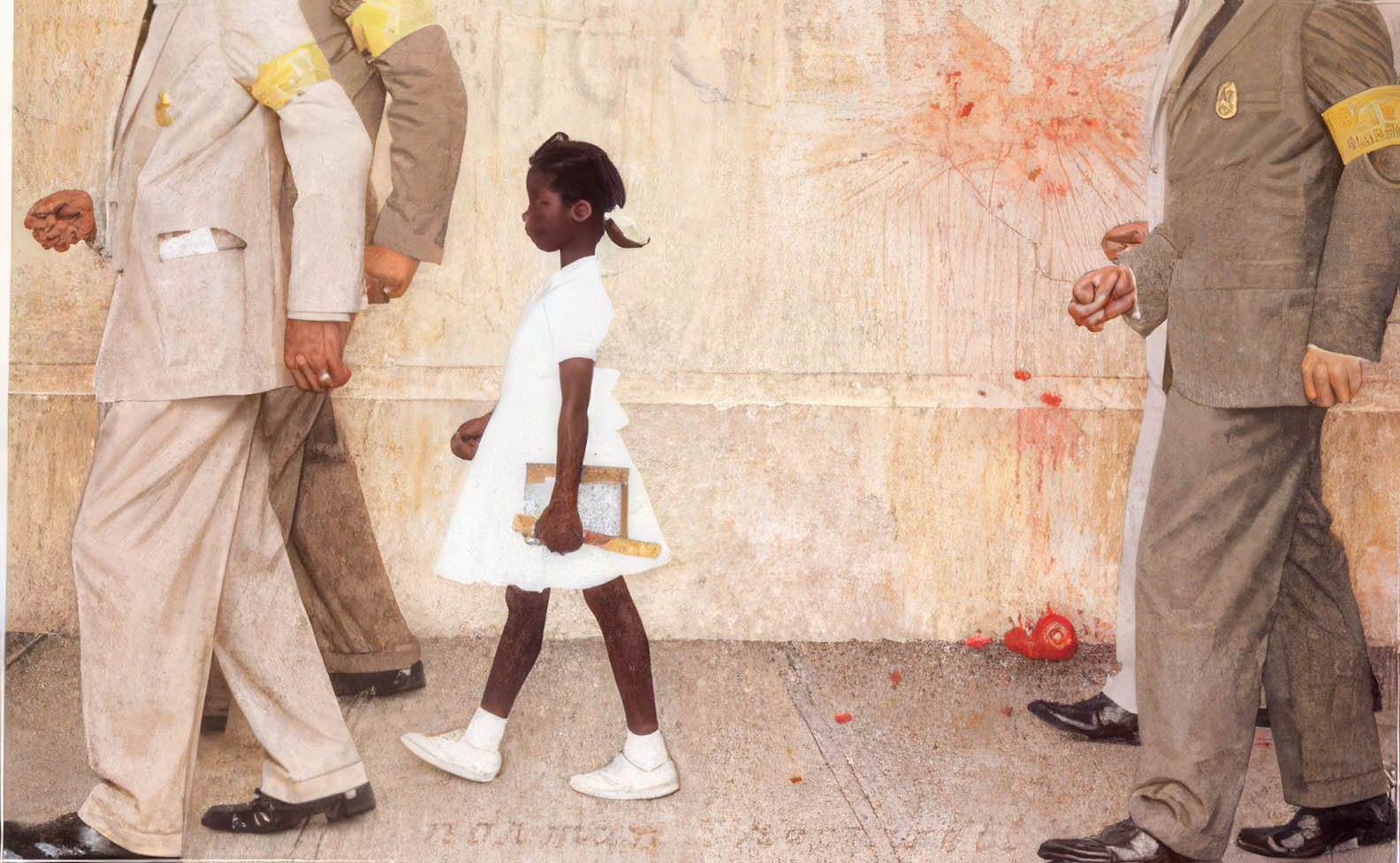
Painting of Courage and Conscience
In the annals of American art, few paintings have captured the soul of a nation grappling with its conscience as powerfully as Norman Rockwell’s The Problem We All Live With. First published in Look magazine on January 14, 1964, this iconic piece stands as a timeless reflection of America’s struggle with racism and the enduring fight for civil rights. Behind its quiet composition lies a loud cry for justice, a visual narrative of a little girl’s bravery in the face of systemic hatred, and an artist’s moral awakening.
But what is the message of The Problem We All Live With? Who is the girl at its center? What does this artwork represent, and where does it reside today? To understand the painting is to journey through a pivotal moment in American history, a story of transformation, both personal and national.
Setting the Stage: Norman Rockwell’s Turning Point
Before exploring the painting itself, it is important to understand its creator. Norman Rockwell (1894–1978) was long considered America’s beloved illustrator, known for his depictions of idealized American life in The Saturday Evening Post. For decades, he painted sentimental scenes of family, community, and national pride, Thanksgiving dinners, barbershop banter, boyhood adventures. Yet, this glossy portrayal of Americana often omitted the harsher realities of race and inequality.
By the 1960s, Rockwell experienced a personal reckoning. America was changing. The Civil Rights Movement was in full force. As sit-ins, marches, and boycotts swept across the South, the brutality of racism could no longer be ignored. Rockwell, too, felt compelled to speak out. In 1963, breaking from his long association with the Post, which had policies against controversial content, he joined Look magazine, a publication more willing to tackle pressing social issues.
It was there, at Look, that Rockwell began creating works that peeled back the veneer of idealized life to expose the deep fractures in American society. The Problem We All Live With would be his most searing contribution.
The Painting: A Visual Protest
The Problem We All Live With is stark and arresting. At the center of the canvas walks a small African American girl, about six years old, dressed in a white dress, white socks, white shoes. She clutches her schoolbooks and a ruler, her expression calm, her posture composed. She is flanked on either side by the torsos of four U.S. federal marshals, heads cropped out of the frame, their serious, suited bodies forming a protective barrier.
The background, a weathered wall, bears the ugly reminders of hatred: the word “NIGGER” scrawled in graffiti, a red splatter suggesting a recently thrown tomato. The contrast between the child’s innocence and the surrounding hostility is jarring.
There are no overt symbols of violence, yet the tension is palpable. Rockwell does not need to show faces twisted with hate; the implications are clear. The absence of the girl’s family, the cropping of the marshals’ heads, the detail of her pristine dress amid the filth, each element tells a story.
But what is the central message of this painting?
The Message: Innocence vs. Injustice
The title, The Problem We All Live With, is crucial. Rockwell does not call it The Problem She Lives With. By including the word “we,” he implicates every American. Racism is not the burden of the oppressed alone; it is a societal affliction, a shared national shame.
At its core, the painting is about moral responsibility. It challenges viewers to confront the discomfort of complicity, to ask themselves: What would I have done? Would I have stood with Ruby? Would I have spoken out? Would I have seen her as a child, not a threat?
The girl’s solemn dignity in the face of overwhelming hate is a powerful indictment of those who allowed, enabled, or ignored racism. Rockwell forces us to see the cost of prejudice not in abstract terms, but through the eyes of a child.
Who Is the Girl in the Painting
The girl in The Problem We All Live With is Ruby Bridges. In 1960, at just six years old, Ruby became the first African American child to integrate an all-white elementary school in the South, William Frantz Elementary School in New Orleans, Louisiana.
Her story is both heartbreaking and heroic. When Ruby entered the school on November 14, 1960, she was met with venomous crowds hurling slurs, threats, and debris. Parents withdrew their children; teachers refused to teach. Only one teacher, Barbara Henry, agreed to educate Ruby, alone, in a classroom that once held dozens.
Ruby’s calm resolve, shielded daily by federal marshals, became a symbol of courage far beyond her years. Her story was so profound that Rockwell, though never having met Ruby at the time, immortalized her experience as a testament to the indomitable human spirit.
Years later, Ruby Bridges reflected on her experience: “I knew that what I was doing was important. I didn’t quite understand it, but I knew it had meaning.” That meaning would resonate through generations, captured forever in Rockwell’s canvas.
What Does the Painting Represent
On one level, the painting represents a historic moment in the civil rights movement. It is a visual documentation of school desegregation following the landmark 1954 Brown v. Board of Education decision. But more broadly, it embodies the broader struggle for equality, dignity, and justice.
It also symbolizes the gap between America’s professed values, freedom, equality, justice, and its lived realities. Rockwell, once the visual poet of American idealism, now held up a mirror to the nation’s failings.
There’s also something deeply personal in Rockwell’s choice to paint this. In using his considerable platform to spotlight a young Black girl’s experience, he took a stand that was rare for a white artist of his stature at the time. It was not just an act of art, it was an act of conscience.
The painting stands not only for the brutality of racism but also for the possibility of moral clarity. Ruby is not just a victim; she is a hero. She represents hope, resilience, and the potential for transformation.
Reactions and Impact
When The Problem We All Live With was first published in Look, it received mixed reactions. While many praised its honesty and courage, others were incensed. Rockwell, a revered figure in American homes, had taken a side in the nation’s most polarizing battle.
He received hate mail. Some fans accused him of betraying his wholesome image. But Rockwell remained steadfast, later saying, “I do care. I care more than some people think.”
The painting helped shift public perception. It gave a face to integration, a name to the faceless crowd. And for many Americans who had never confronted their own prejudices, it opened the door to self-examination.
Over the decades, The Problem We All Live With became an educational and cultural touchstone. It is now studied in schools, displayed in museums, and referenced in discussions about art and activism. It remains one of Rockwell’s most enduring, and important, works.
Where Is the Painting Now
The Problem We All Live With is housed at the Norman Rockwell Museum in Stockbridge, Massachusetts. It is part of the museum’s permanent collection and one of its most treasured pieces.
In 2011, the painting was temporarily displayed at the White House, at the request of President Barack Obama. It hung just outside the Oval Office for several months, a powerful symbol of progress and perseverance. When Ruby Bridges visited the White House and stood beside the painting, now with a Black president looking on, it was a full-circle moment rich with historical resonance.
Legacy and Lessons
Over sixty years after Ruby Bridges made her historic walk, and decades after Rockwell laid down his brush, The Problem We All Live With continues to speak.
It speaks to the power of imagery, to move hearts, to change minds, to challenge the status quo.
It speaks to the bravery of children like Ruby, and the quiet strength of those who stand against hatred.
It speaks to the role of artists in shaping not just culture, but conscience.
It reminds us that while racism may be the problem some would rather ignore, it is the problem we all live with, and thus, the responsibility we all share.
In an age where division and injustice still haunt the headlines, Rockwell’s painting invites us to consider: Who are we protecting? Who are we excluding? And what kind of America are we willing to fight for?
A Masterpiece of Moral Vision
Norman Rockwell’s The Problem We All Live With is more than a painting; it is a moral declaration. Through its simple composition and complex message, it encapsulates a defining moment in American history, and the eternal struggle between justice and hatred, innocence and ignorance.
The little girl in the painting is not just Ruby Bridges. She is every child denied dignity, every soul forced to endure injustice. And the painting is not just a snapshot of 1960, it is a challenge to every generation.
To look at The Problem We All Live With is to be reminded that courage often wears small shoes. That art can be a mirror and a megaphone. That change begins not only in the streets, but also in the heart.
And perhaps most of all, it reminds us that when faced with injustice, silence is never neutral, it is a choice. One that history will remember.




